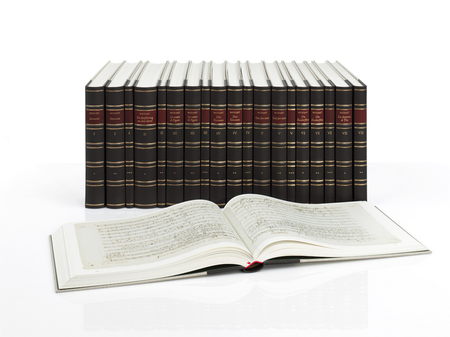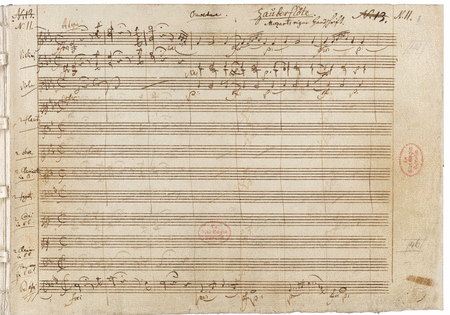Die Zauberflote KV 620
Facsimile of Mozart's autograph score
Details
Description
SKU: BA.BVK01885
Facsimile of Mozart's autograph score. Composed by Wolfgang Amadeus Mozart. Edited by David Packard, Dietrich Berke, and Ulrich Konrad. This edition: facsimile. Half-leather binding. Mozart Operas in Facsimile VI. Facsimile. K. 620. 222/226/151 pages. Baerenreiter Verlag #BVK01885. Published by Baerenreiter Verlag (BA.BVK01885).ISBN 9783761818855. 26 x 35 cm inches.
The Seven Great Operas in Facsimile Editions of Mozart's Autograph Scores
"Idomeneo","Die Entfuhrung aus dem Serail","Le nozze di Figaro","Don Giovanni","Cosi fan tutte","Die Zauberflote","La clemenza di Tito"- Mozart's seven great operas, his brilliant contribution to music theatre and world culture, are unequalled in their depth of human characterisation and musical expression.
Through happy coincidence, all seven opera scores have survived almost complete in Mozart's manuscript. The Packard Humanities Institute (PHI, Los Altos , California ) has now embarked on producing a facsimile edition of the seven autograph scores. Mozart scholars, libraries and of course all lovers of Mozart's stage works now have the opportunity of acquiring these priceless manuscripts in flawless reproductions. At the same time, all risks about preserving Mozart's legacy for the world of music are taken care of.
The Packard Humanities Institute (PHI) charitable foundation, known for its philanthropic programmes in the arts and sciences, has forged an ideal cooperation for the Mozart project. Under the scholarly direction of an editorial board (Ulrich Konrad , David Packard, Wolfgang Rehm , Christoph Wolff; General editor Dietrich Berke) the International Mozarteum Foundation Salzburg and the libraries where Mozart's manuscripts are held are working together with the Packard Humanities Institute.
The production of the volumes is exquisite, for the digitalization of the manuscripts has been undertaken using the latest technology, which allows for an astounding level of authenticity and precision in detail. The printing follows the uncompromisingly high standards demanded by the edition. All seven volumes include essays on the history of literature and ideas by Hendrik Birus , Hans Joachim Kreutzer and Robert Miller as well as musicological introductions by leading Mozart scholars in German and English. The facsimile edition will be distributed by Barenreiter- Verlag .
- consolidation of Mozart manuscripts held in different places
- highest level of precision in reproduction and authenticity of colour through use of the latest technology
- unique offer thanks to project sponsorship by the Packard Humanities Institute (Los Altos, California)
Precision in reproduction thanks to cutting edge technology
In preparing the manuscripts for reproduction, equipment was used in line with the highest technical standards currently available. Mozart's original manuscripts of the seven operas are held by several libraries. For five of the operas, the different acts have even ended up in different libraries following World War II. Thus, the autograph of Act I of"Cosi fan tutte"is in the Jagiellonian Library in Krakow and the second act in the Staatsbibliothek zu Berlin - Preussischer Kulturbesitz . In order to achieve a uniformly high level of precision in reproduction and authenticity of colour both within a work and for all seven editions, the use of the same technical equipment in all the different places was a prerequisite. Specialist from the Salzburg firm ' Kirchberger Photography' were employed, were provided with the latest equipment by the Packard Humanities Institute and also given special additional training in the modern technology by specialists in the USA. Proofs of each edition were compared with the original in each location and improved until the likeness could not be bettered in all details. Mozart's music and text notation is reproduced extremely clearly, and even those places where Mozart corrected or had rubbed out marks he had already made, appear in these editions in a previously unmatched transparency.


 Share
Share